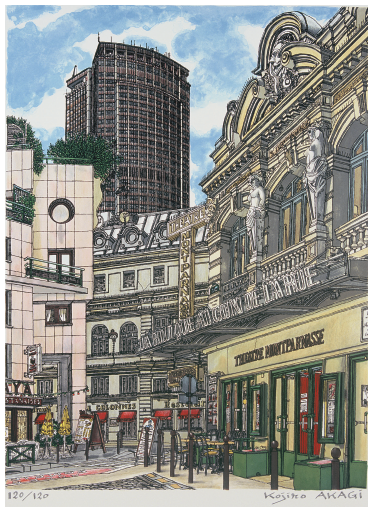Rue de la Gaîté / Rue de la Gaîté, amusement district / ゲーテ通り(ご機嫌通り)
Dublin Core
タイトル (Title)
Rue de la Gaîté / Rue de la Gaîté, amusement district / ゲーテ通り(ご機嫌通り)
テーマ (Subject)
Rue, Lithographie, Montparnasse
詳細 (Description)
A l’origine cette rue menait vers un village voisin. Elle est construite aux environs de 1730 et rassemble de nombreux bars et guinguettes qui connaissent un grand succès. On raconte que le théâtre que l’ont voit sur l’illustration date de 1909, mais, en réalité, il a été reconstruit en 1886. Plusieurs théâtres sont regroupés dans cette rue. Les Mille-Colonnes, que l’on voit en arrière-plan, était aussi un fameux cabaret et le Théâtre de Bobino est incontournable dans l’histoire de la chanson française. C’est toujours un quartier animé en soirée et les restaurants de Yakitori s’y sont rapidement installés. Dans les années 70, c’est ici qu’ouvre le premier restaurant de sushi à Paris, ce qui était rare à l’époque. La propriétaire est une ancienne danseuse de ballet russe. Kunio TSUJI, Makoto OOKA, puis plus tard Jean Paul Gauthier fréquentent le lieu. A cette époque, il était rare de trouver du sushi sur un menu traditionnel et c’était très coûteux. Avec l’aide d’un jeune japonais, la patronne propose un sushi abordable. Pour elle, ce n’est que du poisson sur une boulette de riz avec une sauce. Grâce à cette philosophie, son comptoir est de plus en plus fréquenté. A cette époque, le poisson cru n’est pas très apprécié des Européens et leur « soulève le coeur ». Personne ne se doutait alors que le sushi connaîtrait le succès qu’il a aujourd’hui. A l’arrière-plan, on aperçoit la Tour Montparnasse avec ses cinquante-huit étages construits entre 1969 et 1973. Je recommande sa terrasse panoramique du dernier étage d’où l’on voit tout Paris. Cela vous évitera la longue queue d’attente à la Tour Eiffel !
his street was completed around 1730 and formed the route to the next village from Paris. Bars were established there, and Guinguettes (like karaoke, bars with singing and dancing) did a roaring trade. The theatre depicted was already here in 1819 but it was reconstructed in 1886. Behind it, Colonnes was also a famous cabaret and some more theatres were erected here. Amongst them was Bobino, a theatre in which the history of chansons is immersed.This amusement district still flourishes at night. A yakitori restaurant moved in early on and a nigirizushi restaurant, still rare at that time, opened in the 1970s, the owner being a
former Russian ballerina. Kunio Tsuji, Makoto Ooka and Jean Paul Gaultier ate there. Normally nigirizushi is not included in the menu of Japanese restaurants, being quite expensive, but the proprietress offered simple food with no special sauces. The food was criticized by rich French ladies who judged things by appearances saying that things which look so plain shouldn’t be so expensive so a young Japanese chef was employed to offer cheaper alternatives. More people were able to eat there. Raw fish sounded unpalatable to Westerners even then so it was hard to imagine that sushi would be very popular in the future.Behind this, you can see the 58-storied Montparnasse Tower, which was built from 1969 to 1973. I recommend you get a full view of Paris from its rooftop terrace. It doesn’t have the long queues of the Eiffel Tower.
former Russian ballerina. Kunio Tsuji, Makoto Ooka and Jean Paul Gaultier ate there. Normally nigirizushi is not included in the menu of Japanese restaurants, being quite expensive, but the proprietress offered simple food with no special sauces. The food was criticized by rich French ladies who judged things by appearances saying that things which look so plain shouldn’t be so expensive so a young Japanese chef was employed to offer cheaper alternatives. More people were able to eat there. Raw fish sounded unpalatable to Westerners even then so it was hard to imagine that sushi would be very popular in the future.Behind this, you can see the 58-storied Montparnasse Tower, which was built from 1969 to 1973. I recommend you get a full view of Paris from its rooftop terrace. It doesn’t have the long queues of the Eiffel Tower.
一七三〇年頃から出来ていた街道で、パリ市内からでて隣村にむかう道筋だった。だから酒場が集まり、ガンゲット(カラオケの前身みたいな歌声酒場)が大繁盛だった。この劇場も一八一九年にはもうあったというが、一八八六年に現在の建物に、改築されたものである。奥のコロンヌというのも有名なキャバレーだったし、何軒かの劇場が集まり、シャンソンの歴史には欠かせないボビノ劇場も、この通りにある。 今でも夜は賑わう盛り場で、早くに焼き鳥の店が進出したり、まだ珍しかった握り鮨屋さんが一九七〇年代に出来て、オーナーは白系ロシア人の元バレリーナだった。辻邦生さんとか、大岡信さん、後のジャン・ポール・ゴルチエなんか通っていたものだが、にぎり鮨は普通の日本料理店のメニューにもなく、食べると物凄く高価だったが、タネと台だけの、ソースの工夫もないのに、こんな食べ物がそんなに高い筈がない、物には相場というものがあるという、外見からのマダムの哲学で、日本人の若い職人さんを雇って、本当に安く提供してくれていたのだった。みんながカウンターに通った。火を通さない生魚なんて、まだ西欧人には気持ち悪く、現在のような鮨ブームが起きるなんて、想像もできない頃だった。後ろに一九六九年から一九七三年にかけて建てられた、五十八階建てのモンパルナッスタワーがみえる。この屋上テラスからの、パリ一望の景色もお勧めである。エッフェル塔のような、長蛇の行列が無いだけ助かる。
制作者 (Creator)
Kojiro Akagi (1934-2021)
日付 (Date)
Juillet 2003 / July 2003
権利 (Rights)
Fonds de dotation Kojiro AKAGI
フォーマット (Format)
Lithographie, IDL Graphique, 120 tirages + 30 E.A. romain,
sur papier BFK Rives 48 x 65 cm.
sur papier BFK Rives 48 x 65 cm.
タイプ (Type)
Lithographie
タグ
引用
Kojiro Akagi (1934-2021), “Rue de la Gaîté / Rue de la Gaîté, amusement district / ゲーテ通り(ご機嫌通り),” Kojiro Akagi - Fonds de dotation Kojiro AKAGI , accessed 2025年12月5日, https://kojiroakagi.com/gallery/items/show/101.

